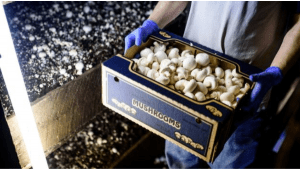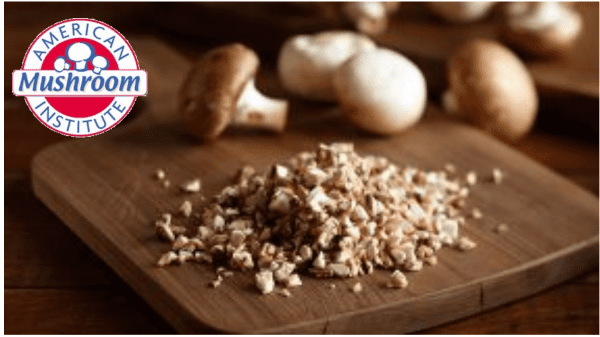Supply chain, Labor, Transportation
and Pandemic Issues Impact Mushroom Production
Avondale, PA – The volume of sales for the 2020-2021 mushroom crop totaled 758 million pounds, down a marked 7 percent from last season, according to USDA’s National Agriculture Statistics Service (NASS) 2021 Report released August 31, 2021.
Value of sales for the 2021-2022 mushroom crop was $1.06 billion, down 8 percent from the previous season. The average reported price was $1.40 per pound, also down, by 1 percent from last year.
United States fresh market sales of Agaricus mushrooms totaled 671 million pounds, down 9 percent from the previous season, while processed sales, at 66.7 million pounds, increased 20 percent from the previous season. Agaricus mushroom volume of sales totaled 758 million pounds, down 9 percent from the 2019-2020 season.


Brown mushrooms made up 26 percent of the total Agaricus volume sold and 30 percent of its value. Price per pound did not change from last year, however.
Value of sales for commercially grown specialty mushrooms in 2020-2021 totaled $66.1 million, down 2 percent from the 2019-2020 season. A specialty grower is defined as having at least 200 natural wood logs in production or some commercial indoor growing area, and $200 or more in sales. The average price received by growers, at $3.21 per pound, was down 16 cents from the revised previous season estimate.
Some of the decreases can be explained by the COVID-19 pandemic, namely, abrupt and prolonged closings of foodservice entities like restaurants, hotels, cruise lines and university systems, among others.
However, American Mushroom Institute BB #:162412 President Rachel Roberts pointed out that, “In addition to the pandemic impacts, commercial mushroom growers saw no end in sight to raw material shortages, the embattled and continued labor shortage and increased transportation, gas and oil costs.
“Despite providing an essential product throughout the pandemic, mushroom farms have not experienced any market changes that reflect the essential nature of the food they produce and the workforce that produces it.”
Roberts added, “All of agriculture has proved its mettle in responding to a crisis in the name of stabilizing the food source for its country. Yet prices and labor policies that don’t reflect market demand for mushrooms continue to artificially squeeze margins that need to expand in order to accommodate the consumers’ booming appetite for mushrooms.”
In general, mushroom growers are working with only 75 percent of the workforce needed to harvest full yields. In fact, mushrooms growers have reported growing beds full of mushrooms with no labor to harvest them.
Roberts pointed to Cremini mushrooms—brown button mushrooms—as an example of what growers are facing. “Cremini mushrooms are in higher demand yet cost more to grow. Add even higher costs, as mentioned above, and these mushrooms are costing mushroom growers much more to grow this year; yet according to the NASS report, the price has remained the same since last year.”
Specialty mushrooms have also been impacted. Bouts of extreme heat have caused dramatically reduced yields in cotton and soybeans, byproducts that are needed to grow Oyster mushrooms. Just about everything along the supply line is delayed, which has hit Shiitake mushrooms particularly hard.
Roberts cautioned, “The increasingly health-conscious consumer is finding more mushrooms to love and more ways to love them, cook them, include them in daily meals and daily nutritional intake and dieting. Mushroom farmers stand ready to meet that enthusiastic demand when pricing and labor barriers can be adequately addressed.”
Strengthening consumer demand is likely to continue, according to a recent study. Dr. Mark Lang, associate professor of marketing at The University of Tampa who specializes in food marketing and retailing, noted that “97% of people who are cooking with mushrooms at home this year plan to cook the same or even more once the pandemic subsides, a sentiment that has increased by 9 points over the prior year.”
According to the “2021 Consumer Study: Blend Attitudes and Behaviors,” which Dr. Lang conducted for the Mushroom Council, consumers are not only cooking more with mushrooms, they also are increasingly aware of their health benefits, including mushrooms as a source of Vitamin D along with other vitamins, nutrients and minerals, and that they are a low calorie, low sodium ingredient.
“Higher consumption, combined with increased awareness about mushrooms’ health benefits – all point to mushrooms holding strong at retail – which naturally carries over to foodservice as menu developers take continued note of mushrooms’ growing prestige.”
The USDA’s NASS provides an annual report of domestic mushroom production, which was released on August 31, 2021. The report covers all domestic production of mushrooms from July 1, 2020 to June 30, 2021. The full report can be found at Mushrooms 08/31/2021 (cornell.edu)


The American Mushroom Institute (AMI), headquartered in Avondale, Pennsylvania, is a national voluntary trade association representing the growers, processors and marketers of cultivated mushrooms in the United States and industry suppliers worldwide. For more information, visit www.americanmushroom.org.



